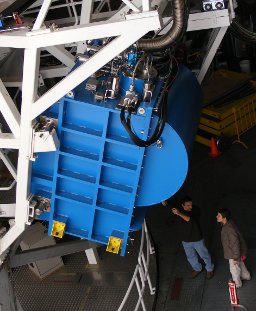
This page contains a number of images made using data from SCUBA-2, sometimes combined with data from other wavelengths.
Click on each image to see the full size version or on the information link below each image.
(Full size version: 1844x2288 pixels, 618 kB JPG)
SCUBA-2 mounted on the James Clerk Maxwell Telescope on Mauna Kea, Hawaii. The instrument weighs 4.5 tonnes and is 3 m high. The massive blue box contains the camera and keeps it cold at only 0.1 degrees C above absolute zero (-273 degrees C). Submillimetre light from the telescope enters through a small window on the left-hand side (behind the white bars) and is directed onto the two sets of detectors. The electronics built by UBC read out the signals and send them to computers which use the UBC software to make pictures for astronomers. (Credit: Joint Astronomy Centre)
(Full size version: 1040x1040 pixels, 383 kB PNG)
SCUBA-2 detects heat! This is the Moon observed using SCUBA-2, at wavelengths of 0.45 mm (top left) and 0.85 mm (top right). The bottom left shows a combination of the SCUBA-2 images which give the temperature of the lunar surface, where red is warmest. At the lower right is a visible light image (used with the permission of the photographer, Mike Kozubal) taken at the same time. The Moon was in "waxing gibbous" phase, meaning that it is on its way to becoming Full. The SCUBA-2 temperature map shows that the unilluminated side of the Moon is colder (green and blue), with the coldest region (blue) being where the Sun last heated the surface. (Credit: University of British Columbia, Mike Kozubal)
(Full size version: 1400x750 pixels, 8 kB PNG)
Jupiter and the same four moons first discovered by Galileo in 1609 (known as the Galilean moons). From left to right is Ganymede, Io, Jupiter itself, Europa and Callisto. While this image looks similar to the view through an optical telescope, SCUBA-2 is detecting the heat emitted from Jupiter and its moons, rather than reflected sunlight. (Credit: University of British Columbia)
(Full size version: 1426x895 pixels, 1.2 MB JPG)
This image shows a SCUBA-2 map of part of our Milky Way galaxy at 0.85 mm (top), compared with an infrared picture of the same area (bottom). Notice how the dark patches and filaments in the bottom image show up as bright areas in the top image. The dust in these areas obscures optical and infrared light from the stars behind them, making them appear dark. SCUBA-2 detects the heat from this dust so that they appear bright at submillimetre wavelengths. The brightest regions mark where new stars are forming, sometimes also showing a red glow in the infrared image as the stars clear away their dusty surroundings. (Credit: Joint Astronomy Centre)
(Full size version: 1073x1493 pixels, 221 kB JPG)
A composite image of the Whirlpool Galaxy (also known as M51). The green image is from the Hubble Space Telescope and shows the optical wavelength. The submillimetre light detected by SCUBA-2 is shown in red (0.85 mm) and blue (0.45 mm). The Whirlpool Galaxy lies at an estimated distance of 31 million light years from Earth in the constellation Canes Venatici. SCUBA-2 detects the warm glow from dust in the dark regions along the spiral arms where new stars are being born. (Credit: Joint Astronomy Centre, University of British Columbia and NASA/HST/STScI)
(Full size version: 1090x728 pixels, 774 kB JPG)
The DR21 region is a busy star-forming region. The left hand panel shows the SCUBA-2 image while the right-hand panel is a close-up view where the SCUBA-2 data (in orange) have been overlaid on an infrared image. The peak of the submillimetre light seen with SCUBA-2 houses a very massive young star (10 times more massive than our Sun) which is pushing huge amounts of gas and dust away from it in two opposite streams. DR21 lies around 10000 light years away within our galaxy in the constellation of Cygnus. (Credit: Joint Astronomy Centre)
(Full size version: 617x645 pixels, 408 kB PNG)
NGC 7331 at 3 wavelengths. Left: Herschel 0.25 mm. Middle: SCUBA-2 0.45 mm. Right: SCUBA-2 0.85 mm. NGC 7331 is a spiral galaxy that lies about 50 million light years away in the constellation Pegasus. SCUBA-2 shows the central ring of dust in greater detail than before. (Credit: Joint Astronomy Centre, Herschel KINGFISH consortium)
(Full size version: 1106x734 pixels, 821 kB PNG)
This picture shows the tangled web of star-forming dust clouds near the centre of our Milky Way galaxy, about 26,000 light years away in the constellation of Sagittarious. The image covers an area about twice the diameter of the full moon, or about 500 light years at the distance of the centre of our galaxy. A map of this size would have taken days with older instruments, but SCUBA-2 needed only a couple of hours. Close-up views of four regions show the complex arrangement of dust clouds in more detail. (Credit: Joint Astronomy Centre)
(Full size version: 2500x2000 pixels, 3.0 MB JPG)
(Full size version: 2000x1500 pixels, 3.1 MB JPG)
The James Clerk Maxwell Telescope (JCMT) on Mauna Kea in Hawaii. With a diameter of 15 metres the JCMT is the largest telescope in the world designed specifically to operate at submillimetre wavelengths. The dish is protected by a Gore Tex membrane which is transparent at submillimetre wavelengths. The telescope is named for the 19th century Scottish physicist who showed that electricity and magnetism are related, and is jointly run by the UK, Canada and the Netherlands. (Credit: Joint Astronomy Centre)